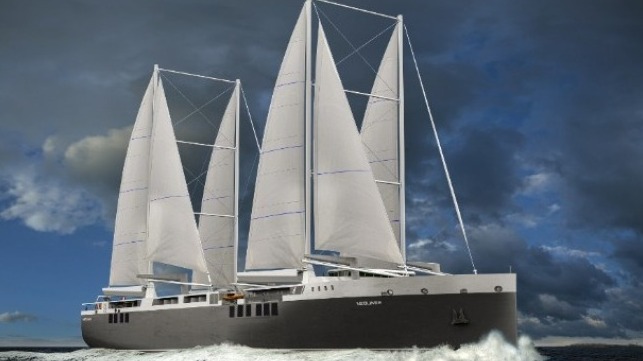Michelin Commits to Shipping Product Transatlantic on Sail Cargo Ship

France’s Michelin Group joined a growing number of global brands committing to use a sail-powered carbon-free shipping alternative for its products. Michelin announced that has signed a letter of commitment for maritime transport of containers of its pneumatic tires aboard NEOLINE, the French start-up that plans to build two cargo ships that will use sails for their main propulsion.
Calling it a “test initiative to help decarbonize Michelin's logistics operations,” the French manufacturer committed to the transportation of containers of its product from Halifax, Canada to Saint-Nazaire - Montoir de Bretagne, France as soon as the first cargo sailboat is commissioned. NEOLINE plans to open its transatlantic service with a first vessel in operation by 2023 and a second vessel scheduled a year later. Michelin committed to gradually growing its business with NEOLINE to at least 50 percent of the group's containers transported on this route.
“This initiative and this new partnership promote innovation in the field of carbon-free transport,” said Pierre-Martin Huet, Michelin Group Supply Chain Director. “This first step in carbon-free shipping is fully in line with the CSR strategy of Michelin's operations. It will contribute to achieving the objective of reducing CO2 emissions from logistics by 15 percent in absolute terms between 2018 and 2030.”
NEOLINE's plan calls for the construction of two 446-foot long vessels that will get their main power from 4200 m2 of sails. Relying on wind as the main propulsion for its cargo ships, NEOLINE is promoting its services to shippers offering a 90 percent reduction in CO2 emissions related to transatlantic maritime freight transport.
The initial plan for the sail cargo ships to maintain service between Baltimore, Maryland via Halifax and the French archipelago of Saint Pierre and Miquelon and crossing the Atlantic to Saint-Nazaire - Montoir de Bretagne. Founded in 2015 after four years of study, NEOLINE says that it has simulated operational conditions based on five years of meteorological data to select the route which it can be operated with sailings every 14 days maintaining a commercial speed of 11 knots.
They are planning two pilot project ships as a demonstration and proof of the concept. The design for the ship includes duplex rigging and anti-drift fins, which NEOLINE says favor regular and efficient navigation under sails. These elements will also be retractable to allow access to a majority of ports.
Equipped with two loading ramps, the Neoliner is designed to load cargo units of various sizes and types of packaging in two loading spaces, fully protected and secured in the event of rough conditions. Capacities will be optimized by the use of mobile decks permitting the ship to load heavy or oversized shipments up to 200 tons and a height of 32 feet. The design has a carrying capacity of 280 TEUs, 5,000 tons of conventional cargo, or up to 1500 linear meters of ro-ro cargo such as 500 cars.
NEOLINE has international patents on the design. The company, however, is yet to place a firm construction order for the first pilot ship.
“We are honored to welcome on board the Michelin Group, an emblematic French player strongly committed to innovation and sustainable mobility,” said Jean Zanuttini, President of NEOLINE. “This first commitment concerns Eastbound flow (from the Americas to Europe) and comes in addition to an already well-filled order book in Westbound direction (from Europe to the Americas). With our sailing cargo ships, we are developing a mode of transport that is more environmentally friendly, adapted to the current economic and logistical reality of shippers, and not dependent on fossil fuels.”
In addition to the agreement with Michelin Group, NEOLINE has announced agreements with other major French industry leaders. including Groupe Renault, Groupe Beneteau, Manitou Group, and Jas Hennessy & Co.
Main Characteristics Neoliner
Length: 136 m (446 feet)
Width: 24.2 m (79 feet)
Water draft: 5.5 m (port) / 14 m (offshore) (18 feet / 46 feet)
Air draft: 67 m / 41 m (tilted masts) (220 feet / 135 feet)
Displacement: 11000 t
Deadweight capacity: 5000 t
Total sail surface: 4200 m²
Power (diesel-elec.): 4000 kW
Commercial speed: 11 knots
Max. engine speed: 14 knots
Crew members: 14
Ramp capacities: 9,80m (height) by 12,60m (width)
